This text was obtained via automated optical character recognition.
It has not been edited and may therefore contain several errors.
hand, had less interest in protecting the railroads than in preserving his army intact. It appeared on February 8 that Marion Baxter was about to lend a hand in a pitched battle with Sherman?s Yanks. That morning the infantry divisions under William W. Loring and Samuel G. French converged near Morton, a town on the Southern Railroad of Mississippi, about 35 miles east of Jackson. Preparations had been made for a stand against the Federals. Cold rations were in the haversacks, and extra ammunition had been issued each soldier. Skirmishing was well under way when Polk decided not to risk these two divisions and ordered them along with Maj. Gen. S. D. Lee?s cavalry, which had been contesting the Union advance since Sherman?s columns had crossed the Big Black, to fight a delaying action as they fell back toward Meridian. It took Sherman nearly a week to advance the 70 miles between Morton and Meridian. Confederate skirmishing during the delaying action was effective, but the outcome of the operation must have been obvious from the start. Presumably the delay allowed Polk to remove some of the military supplies in Meridian, but he had no hope of successfully defending the town against the Federals. Finally on the 14th troops of Sherman?s command entered Meridian. A few hours earlier the Southern troops had left for Demopolis, Alabama, where Polk established his headquarters. The five days that followed Sherman?s occupation of Meridian were five days of grim destruction, as 20,000 Federal troops took torch, explosives, crowbar, and sledge to every Confederate installation within a radius of 20 miles. When the Federals bedded down on the night of February 19, Meridian was in ruins, 115 miles of track destroyed, and thousands of feet of bridges and trestles burned to the ground or to the waterline. That night Sherman declared himself pleased with the result of his operation to date, but he was still waiting for the cavalry support he had ordered from Memphis. This cavalry support was a force of 7,000 commanded by Brig. Gen. William S. Smith whose orders directed him to leave camp near Memphis on February 1. He was expected to join 61

Baxter, Marion Francis Marion-Francis-Baxter-Bio.-061